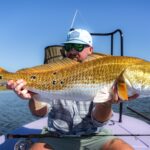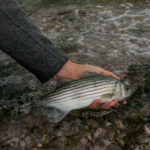
Louisiana Bull Reds Up for Harvest Again: H.B. 604 Must Not Pass
Photo Credit: Carter Abramson | Trevor Johnson Every now and then, we encounter something so
The Atlantic States Marine Fisheries Commission is the biggest hurdle to striped bass management
Thanks for being patient! The Atlantic States Marine Fisheries Commission meeting that will decide the future of striped bass is only a month away. The entire community has to mobilize if we are to have any hope of recovering the most iconic fish on the East Coast.
Have you ever wondered why our so many species managed by ASMFC are in trouble? How can any commission tasked with managing fish stocks have such an abysmal track record and still exist?
ASMFC was created in 1942 to address food supply concerns during WWII. It was not initially intended to have any authority to manage fisheries. Such authority was only granted, with respect to striped bass, after the Atlantic Striped Bass Conservation Act was made law in 1984; ASMFC had no authority to manage other coastal species until Congress passed further legislation in 1993.
A quarter-century later, ASMFC’s only claim to fame has been the recovery of striped bass in 1995. Today, even that accomplishment has been superseded by too many years of inaction in the face of a declining striped bass stock, which has culminated in the recent stock assessment’s finding that striped bass are overfished and overfishing is occurring.
One can only wonder why fish stocks managed by other federal fishery management councils are recovering while critical species like weakfish, striped bass, river herring/shad, lobster, and American eel are all doing so poorly. We’ve done some research on the issue and our conclusion is that the management system needs to change. We have to stop treating the symptoms and go directly after the disease. The real issue is the framework under which ASMFC operates.
At the federal level, eight regional fishery management councils were set up under The Magnuson Stevens Fishery Conservation and Management Act. Such councils are required, by law, to manage fisheries in a very different way than striped bass are currently managed. If striped bass were managed under a similar framework, it is very unlikely that we would be in the mess that we are in now.
We are about to get technical. There’s no other way to explain the issue in a fair manner. We are going to ride the fine line between delivering the facts and making the article readable for fishermen. We will compare and contrast the management framework between the councils and the commission, and you will see for yourself how ASMFC loopholes are exploited and why our fisheries suffer.
Council Structure/Magnuson Stevens: Striped Bass are not managed this way
Magnuson-Stevens is a comprehensive federal fishery management statute, which governs all fishing in federal waters. However, with very limited exceptions that do not apply to the striped bass fishery, Magnuson-Stevens does not give federal fishery managers the authority to manage fish in state waters,[1] even if the same stock of fish is federally managed when present in the United States Exclusive Economic Zone.[2] Thus, as the law is currently written, federal fishery managers, acting pursuant to Magnuson-Stevens, can’t manage striped bass. But we can seriously consider legislating a new framework for ASMFC that would mirror the structure of a federal fishery management council.
Let’s assume that striped bass could be and could have been managed pursuant to Magnuson-Stevens. In that case, the following provisions of the statute would be relevant.
“The term ‘optimum’ with respect to the yield from a fishery, means the amount of fish which—
(i) be as short as possible, taking into account the status and biology of any overfished stocks of fish, the needs of fishing communities, recommendations by international organizations in which the United States participates, and the interaction of the overfished stock of fish within the marine ecosystem; and
(ii) not to exceed 10 years, except in cases where the biology of the stock of fish, other environmental conditions, or management measures under an international agreement in which the united states participates dictates otherwise…”[10]
Magnuson-Stevens also provides for judicial review of fishery managers’ actions,[11] which can and has led to courts compelling the National Marine Fisheries Service to revise such actions and adopt measures that comply with the provisions of that law.[12]
ATLANTIC STATES MARINE FISHERIES COMMISSION
The ASMFC was created by an interstate compact that was first ratified in 1942.[13] For its first four decades, it played a purely advisory role, and could not compel member states to adopt its fishery management recommendations.
The collapse of the Atlantic striped bass stock in the late 1970s and early 1980s led Congress to pass the Atlantic Striped Bass Conservation Act (Striped Bass Act)[14] in 1984, which for the first time gave the ASMFC the authority to compel the states to adopt the measures in its striped bass management plan; a state’s failure to comply with the terms of such plan would result in the Secretary of Commerce declaring a moratorium on striped bass fishing in the noncompliant state, which would last until such state elected to come into compliance.[15]
Because of the ASMFC’s eventual success in rebuilding the striped bass stock, it was given similar authority to manage all coastal fisheries under its jurisdiction in 1993, when the Atlantic Coastal Fisheries Cooperative Management Act (Coastal Fisheries Act)[16] was passed. That statute, although based on the Striped Bass Act, gave the Secretary of Commerce greater discretion to determine whether to impose a moratorium on a noncompliant state. Under the Coastal Fisheries Act, the Secretary had to determine not only that a state was not in compliance with a provision of the relevant management plan, but also that such provision was “necessary” to conserve the fishery in question.[17]
Although both statutes provided the ASMFC with mechanisms that it could use to enforce the provisions of its management plans, there was no federal law that dictated what such provisions must be. The ASMFC is under no legal obligation to prevent overfishing, rebuild overfished stocks or base its management measures on the best available science.
Instead, its primary guiding document is its Interstate Fisheries Management Program Charter (ASMFC Charter),[18] which states that “It is the policy of this Commission that its [Interstate Fisheries Management Program] promote the conservation of Atlantic coastal fisheries resources, be based on the best scientific information available, and provide adequate opportunity for public participation.”[19]
The ASMFC Charter supports such policy in its “Standards and Procedures for Interstate Fishery Management Plans,” (ASMFC Standards)[20] where it states that “Above all, [a fishery management plan] must include conservation and management measures that ensure the long-term biological health and productivity of fishery resources under management.”
To that end, the ASMFC Standards echo some of the most important provisions of Magnuson-Stevens, providing, among other things, that “Conservation programs and management measures shall be designed to prevent overfishing and maintain over time, abundant, self-sustaining stocks of coastal fishery resources. In cases where stocks have become depleted as a result of overfishing and/or other causes, such programs have been designed to rebuild, restore, and subsequently maintain such stocks so as to assure their sustained availability in fishable abundance on a long-term basis.”
The ASMFC Standards also provide that “Conservation programs and management measures shall be based on the best scientific information available.”
While the ASMFC Charter, including the ASMFC Standards, appear to provide a management regime somewhat similar to that created by Magnuson-Stevens, it lacks one important feature, and that is legal accountability. Should the ASMFC, or any of its fishery-specific management boards, elect not to adhere to the ASMFC Charter or ASMFC Standards, there is no statutory provision that authorizes judicial review of any ASMFC-authored management plan, or any amendment or addendum thereto.
Such lack of statutory authority, combined with the court decision in New York v. Atlantic States Marine Fisheries Commission,[21] which found that the ASMFC was neither a federal agency nor quasi-agency, and so not subject to judicial review pursuant to the relevant provisions of the Administrative Procedures Act,[22] allows the ASMFC to violate the express language of the ASMFC Charter and any ASMFC-authored management plans with impunity, knowing that any such violation will not be set aside by the courts.
THE MANAGEMENT PLAN
The ASMFC manages striped bass pursuant to its Interstate Fishery Management Plan for the Striped Bass,[23] which has been amended on six different occasions since it was first released in 1981. Current striped management is informed by Amendment 6 to the Interstate Fishery Management Plan for Atlantic Striped Bass[24] (Amendment 6) and four related addendums.
The stated goal of Amendment 6 is “To perpetuate, through cooperative interstate fishery management, migratory stocks of striped bass; to allow commercial and recreational fisheries consistent with the long-term maintenance of a broad age structure, a self-sustaining spawning stock; and also to provide for the restoration and maintenance of essential habitat.”[25]
Amendment 6 also recommends seven objectives in support of such goal. Three of those objectives are particularly relevant to this memorandum. They are
In order to help achieve its goal and meet its objective, Amendment 6 included five “management triggers” that require the Management Board to take remedial action should certain specified events occur. Those management triggers, and the related actions required of the Management Board, are
1) If the Management Board determines that the fishing mortality threshold is exceeded in any year, the Board must adjust the striped bass management program to reduce the fishing mortality rate to a level that is at or below the target within one year.
2) If the Management Board determines that the biomass has fallen below the threshold in any give year, the Board must adjust the striped bass management program to rebuild the biomass to the target level within the timeframe established in Section 2.6.2.
3) If the Management Board determines that the fishing mortality target is exceeded in two consecutive years and the female spawning stock biomass falls below the target within either of those years, the Management Board must adjust the striped ass management program to reduce the fishing mortality rate to a level that is at or below the target within one year.
4) If the Management Board determines that the female spawning stock biomass falls below the target for two consecutive years and the fishing mortality rate exceeds the target in either of those years, the Management Board must adjust the striped bass management program to rebuild the biomass to the target level within the timeframe established in Section 2.6.2.
5) The Management Board shall annually examine trends in all required Juvenile Abundance Index surveys. If any JAI shows recruitment failure (i.e., JAI is lower than 75% of all other values in the dataset) for three consecutive years, then the Management Board will review the cause of the recruitment failure (e.g. fishing mortality, environmental conditions, disease etc.) and determine the appropriate management action. The Management Board shall be the final arbiter in all management decisions.[27]
Section 2.6.2 of Amendment 6, which is referenced in the second and fourth management trigger, states that “If at any time the Atlantic striped bass population is declared overfished and rebuilding needs to occur, the Management Board will determine the rebuilding schedule at that time. The only limitation imposed under Amendment 6 is that the rebuilding schedule is not to exceed 10 years.”[28]
The 2018 Assessment represents the best available scientific information. It has found that the stock is overfished and subject to overfishing.
While that would seem to require remedial action under both Amendment 6 and the ASMFC Charter, there is no legal requirement that the ASMFC take any action at all. The Management Board could have voted against accepting the 2018 Assessment for management purposes[29], and can choose to neither end overfishing nor rebuild the overfished stock. The Management Board has even discussed drafting a new amendment that might change the goals and objectives of the management plan and adopt new reference points that countenance a smaller female spawning stock biomass and higher fishing mortality threshold.[30] A motion to proceed with such amendment will be considered at the Management Board’s August 2019 meeting.[31]
Under the hypothetical Magnuson-Stevens scenario, the Management Board would be unable to arbitrarily reject the 2018 Assessment, which represents the best available science. It would be legally bound to end overfishing and rebuild the striped bass stock, and almost certainly would be required to accomplish such rebuilding in no more than 10 years. There seems to be no biological obstacle to the 10-year time frame, as only 10 years expired between the time ASMFC adopted Amendment 3 in 1985, in an effort to rebuild the then-collapsed stock, and the time when the stock was declared fully rebuilt in 1995.
While the possibility of the Management Board amending the reference points would not disappear under the Magnuson-Stevens scenario, making such changes would be more difficult. The current female spawning stock biomass reference point is derived from biomass levels during the period 1960-1972, when the stock was believed to be healthy.[32] While, under current law, the ASMFC may arbitrarily change the reference points if it opted to do so, if the fishery was governed by Magnuson-Stevens, any such change would have to be supported by better science than that underlying the existing reference points.
If striped bass had been managed pursuant to Magnuson-Stevens during the period 2011-present, the Management Board would probably have taken a more risk-averse approach to striped bass management than it actually did. Such management would have included the adoption of annual catch limits and accountability measures, and probably would have resulted in a plan to rebuild the stock in no more than 10 years having been adopted in 2015 or 2016.
The Chesapeake Bay recreational sector’s continuing failure to achieve the fishing mortality reduction required by Addendum IV would not have been tolerated; instead, accountability measures would have been imposed to end, and possibly to require restitution for, such overfishing.
It is very likely that, had bass been managed with measures adopted pursuant to Magnuson-Stevens, the female spawning stock biomass would have been larger than it is today, that the fishing mortality rate would have been lower, and that the stock would have been in better condition than it is under the ASMFC’s historical management approach.
If all of this is difficult for you to wrap your head around, we prepared an infographic that hits the big points. It will appear at the bottom of this article.
The bottom line is that all of the language in the ASMFC Charter, and even in ASMFC management plans, are merely aspirational, and cannot be legally enforced. ASMFC is allowed to violate its own plans and policy with absolutely no repercussions. That’s where the rubber meets the road. As an example, the current suggested reduction of 17% doesn’t rebuild the stock within any established timeframe, much less within the ten years required by Amendment 6. It only ends overfishing. While Amendment 6 seemingly binds ASMFC to rebuild striped bass in no more than ten years, that isn’t even on the table right now. We are watching the failings of ASMFC unfold before our eyes yet again.
This is unacceptable. Countless coastal communities depend on striped bass in one way or another. Our members from Maine to North Carolina need abundant populations in order to pay their mortgages, clothe their children, and at least have an opportunity to pursue their dreams. Instead of rebuilding the stock, certain states would rather lower the threshold so we will never have the same number of fish in the water. Instead of doing the right thing and following science, certain states would like to arbitrarily lower the bar because they think they can get away with it. Well, they can’t.
We are hereby putting ASMFC on notice. If they choose to not follow their own rules yet again, we will do everything in our power to legislate a new framework that won’t allow them to mismanage the resource
Here’s an infogrphic we did to summarize.

[1] 16 U.S.C. 1856
[2] For the purposes of this memorandum, the Exclusive Economic Zone includes all waters between 3 and 200 miles off the coast of the United States.
[3] 16 U.S.C. 1851(a)(1)
[4] 16 U.S.C. 1802(33)
[5] 16 U.S.C. 1851(a)(2)
[6] 16 U.S.C. 1852(h)(6)
[7] 16 U.S.C. 1853 (a)(10)
[8] 16 U.S.C. 1853 (a)(12)
[9] 16 U.S.C. 1853 (a)(16)
[10] 16 U.S.C. 1854 (e)(4)
[11] 16 U.S.C. 1855(f)
[12] See, as an example, Natural Resources Defense Council v. Daley, 209 F. 3rd 747 (2000)
[13] Pub. L 77-539
[14] 16 U.S.C. 5151 et seq.
[15] 16 U.S.C. 5154
[16] 16 U.S.C. 5101 et seq.
[17] 16 U.S.C. 5106(a)(2)
[18] Available at http://www.asmfc.org/files/pub/ISFMPCharter_Nov2017.pdf
[19] Atlantic States Marine Fisheries Commission, Interstate Fisheries Management Program Charter, Sec. One, sub. (c)
[20] ASMFC Charter, Sec. Six
[21] 609 F.3rd 524 (2nd Cir., 2010)
[22] 5 U.S.C. 702
[23] Atlantic States Marine Fisheries Commission, Interstate Fisheries Management Plan for the Striped Bass, 1981, available at http://www.asmfc.org/uploads/file/1981FMP.pdf
[24] Atlantic States Marine Fisheries Commission, Amendment 6 to the Interstate Fishery Management Plan for Atlantic Striped Bass, 2003, available at http://www.asmfc.org/uploads/file/sbAmendment6.pdf
[25] Ibid., p. iv
[26] Ibid., pp. iv-v
[27] Ibid., p. 31
[28] Ibid., p. 22
[29] The Management Board did vote to accept the 2018 Assessment for management purposes at its May 2019 meeting.
[30] See Atlantic States Marine Fisheries Commission, Proceedings of the Atlantic States Marine Fisheries Commission Striped Bass Management Board, May 1, 2018, pp. 1-16, available at http://www.asmfc.org/uploads/file/5bdcadd1AtlStripedBassBoardProceedingsMay2018.pdf
[31] Atlantic States Marine Fisheries Commission, “ASMFC Summer Meeting—August 6-8, 2019m Preliminary Agenda,” available at http://www.asmfc.org/home/2019-summer-meeting
[32] Atlantic States Marine Fisheries Commission, Amendment 6, p. 1

Photo Credit: Carter Abramson | Trevor Johnson Every now and then, we encounter something so

This past weekend, ASGA proudly sponsored the Dirty Carp Tournament in Louisiana — and no, you didn’t misread that.

After years of data pouring in from The Albie Project, advocacy, persistence, and support from

This morning, the Connecticut Environment Committee held a hearing on House Bill 6248, a bill
We rely on our members and donations to keep fighting for a sustainable tomorrow in marine conservation.
GIVE THE GIFT OF FISHERIES CONSERVATION THIS HOLIDAY SEASON. SHOP ASGA GOODS THAT FUND FISHERIES RESEARCH & ADVOCACY CAMPAIGNS
JOIN ASGA IN CALLING FOR CRITICAL MANAGEMENT ACTION AFTER YEARS OF SPAWN FAILURES & POOR MANAGEMENT.
By using this website, you agree to our use of cookies. We use cookies to provide you with a great experience and to help our website run effectively. To learn more, please review our privacy policy.
5 Responses
Having served as a Commissioner from the State of Maryland for 3.5 years, it became very apparent that the ASMFC would be hard pressed to accomplish any useful methods to conserve various species of fish. I have seen where the Striped Bass here in Maryland has gone from bad to worse and there does not seem to be a valid plan by ASMFC to alleviate this problem. I fully agree that it is time to pursue another method of fish conservation other than what ASMFC has done for so many years.
Wow what an article. I’m going to have to print it out to try and digest it all.
What I see on the Canal is enough to make you sick.
Please tell me / us what we can do.
After experiencing the many failures brought to our country by ASMFS…..
I am still puzzled by the fact that nobody within the organization , employees and appointees has ever lost their job for self evident incompetence. Federal agencies eventually will accomplish the exactly opposite mission for which they were created? ASMFC history has long supported this adage. Strangely the ASMFC newsletter is stuffed full of these cogs receiving what appears to be self invented flowery awards endlessly. ASMFC has now become the problem . Perhaps another invented award could be “Extirpation of the Year” ?